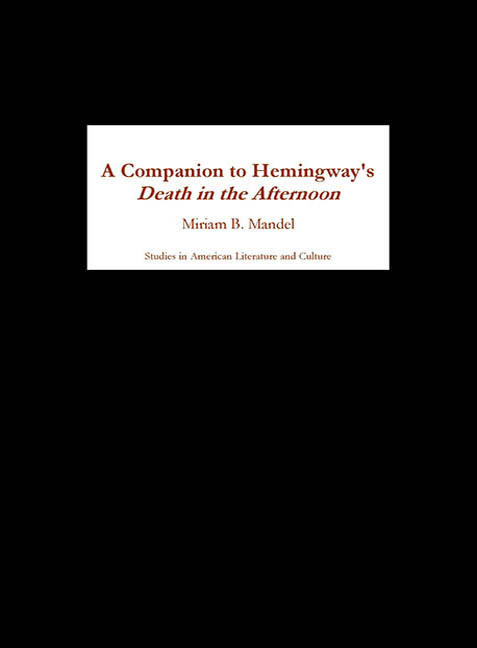Book contents
- Frontmatter
- Dedication
- Contents
- Acknowledgments
- Hemingway Works That Address the Bullfight
- A Note on the Text of Death in the Afternoon
- Introduction
- Composition, Sources, and Backgrounds
- Reading Texts, Paratexts, and Absence
- “The Real Thing–? Representing the Bullfight and Spain in Death in the Afternoon
- “Very Sad but Very Fine”: Death in the Afternoon 's Imagist Interpretation of the Bullfight-Text
- “Far from Simple”: The Published Photographs in Death in the Afternoon
- Deleted “Flashes”: The Unpublished Photographs of Death in the Afternoon
- “¿Qué tal, hombre, qué tal?”: How Paratexts Narrow the Gap between Reader and Text in Death in the Afternoon
- On Authorship and Art
- And What Came After
- Works Cited
- Notes on the Contributors
- Index
“Very Sad but Very Fine”: Death in the Afternoon 's Imagist Interpretation of the Bullfight-Text
from Reading Texts, Paratexts, and Absence
Published online by Cambridge University Press: 27 April 2017
- Frontmatter
- Dedication
- Contents
- Acknowledgments
- Hemingway Works That Address the Bullfight
- A Note on the Text of Death in the Afternoon
- Introduction
- Composition, Sources, and Backgrounds
- Reading Texts, Paratexts, and Absence
- “The Real Thing–? Representing the Bullfight and Spain in Death in the Afternoon
- “Very Sad but Very Fine”: Death in the Afternoon 's Imagist Interpretation of the Bullfight-Text
- “Far from Simple”: The Published Photographs in Death in the Afternoon
- Deleted “Flashes”: The Unpublished Photographs of Death in the Afternoon
- “¿Qué tal, hombre, qué tal?”: How Paratexts Narrow the Gap between Reader and Text in Death in the Afternoon
- On Authorship and Art
- And What Came After
- Works Cited
- Notes on the Contributors
- Index
Summary
He gave emotion always and, finally, as he steadily improved his style, he was an artist.
Death in the Afternoon, 79In the act of writingDeath in the Afternoon Hemingway was subtly announcing the completion of the first phase of his life and career as artist. He was telling his readers, present and future, how long and necessary this first learning phase is. Having overcome his initial difficulties, he tells us, the writer finally knows what he did not know before. He can now see beyond appearances, he sees meaning outside himself because he is now able to know himself. He has learned to differentiate between his own real feelings and the feelings he has been taught he is supposed to have; in other words, he has learned to disregard his white, Protestant, middle-class upbringing. His years abroad have given him the needed distance from his native America, enabling him to become himself. About ten years have been necessary for him to write about things that he has slowly learned to understand and appreciate, things that he never knew before he came to Europe and saw the war and the bullfights.
To write about these matters, Hemingway employs a phenomenological approach which involves: (1) exposure to external action (watching, listening), (2) internalization (responding emotionally), (3) selective recall (isolating the elements in the external action that provoked the emotion), and (4) selective telling (stating purely). The process follows a movement from the outside to the inside and to the outside again: the transmutation of external action into internal experience and then the transmutation of that experience into text. In Death in the Afternoon, Hemingway indicates that his genuine interest in the bullfight was always subordinated to a higher interest, his interest in writing about the bullfight, or what is the same, his interest in literature.
Because the bullfight is radically foreign to the non-Spanish mind, the writer needs to make an extra effort both to understand it himself and to explain it to his readers. The bullfight is too complex to be readily acceptable or understandable: it is both an event and a sign, or symbolic representation of events; it is business, history, and art.
- Type
- Chapter
- Information
- A Companion to Hemingway's Death in the Afternoon , pp. 143 - 164Publisher: Boydell & BrewerPrint publication year: 2004

